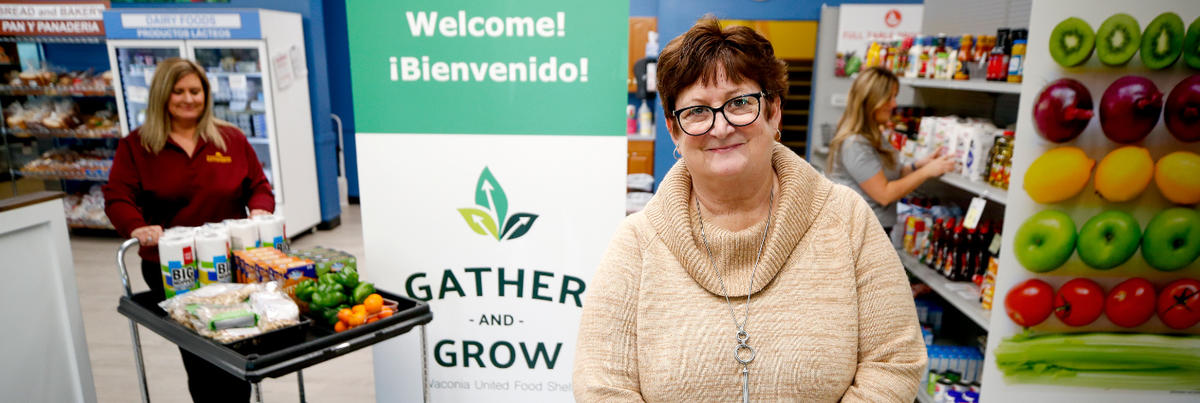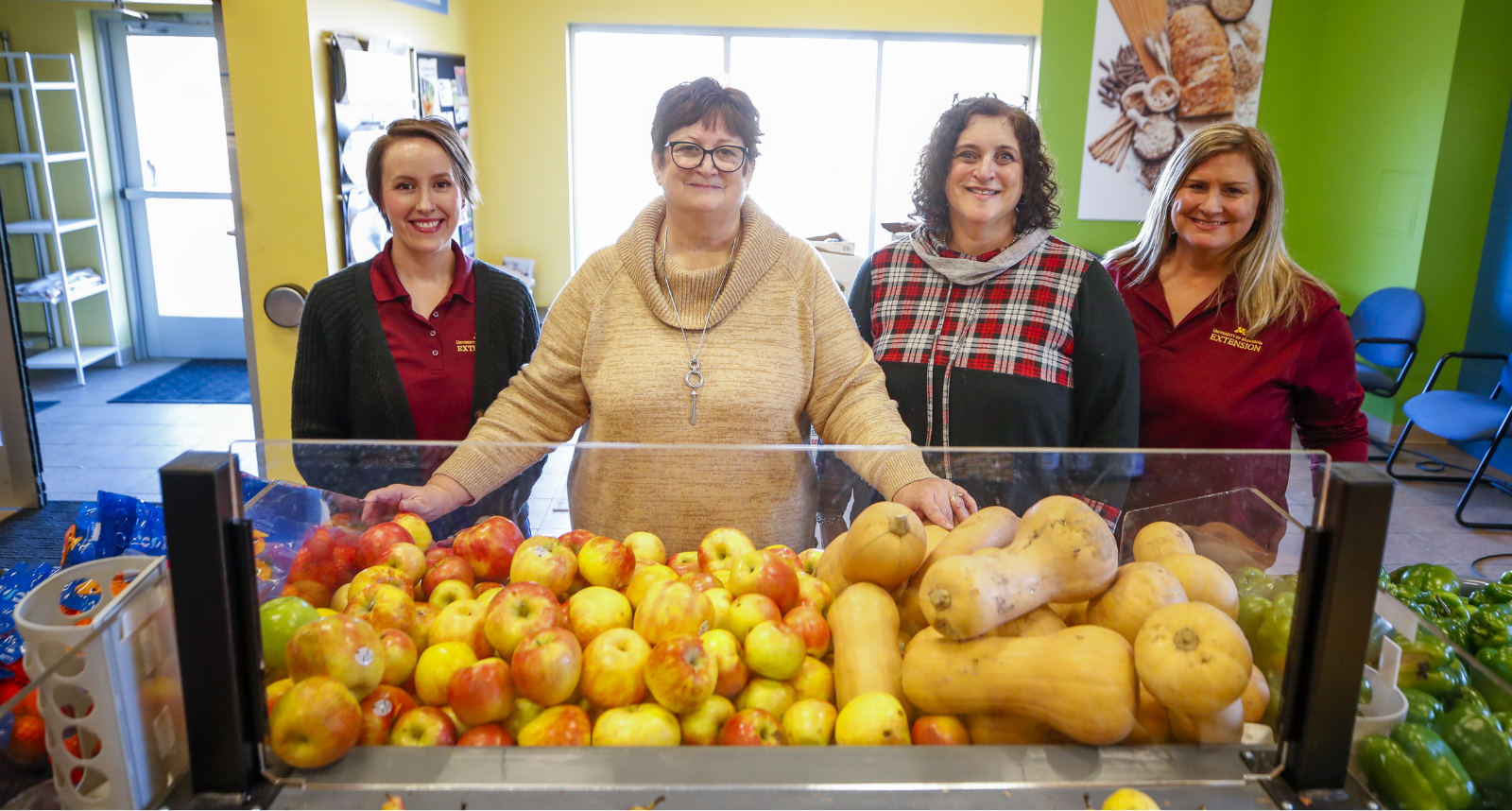

Dianne Davis-Kenning, left, and volunteers at Gather and Grow


At a SuperShelf, shoppers enjoy not only respect, but the freedom to make their own food choices.
“There’s no volunteer hovering behind you, telling you to remove items from your cart, or not to take one,” explains SuperShelf Program Coordinator Dianne Davis-Kenning, at U of M Extension.
So different is a SuperShelf from a regular food shelf that, Davis-Kenning says, “One guy came in and asked where the prices were because it was so nice, he thought it was a grocery store.”

Susie West at Bountiful Basket Food Shelf, Carver County-Chaska
But SuperShelf shoppers aren’t any different from the rest of us.
With more than half of Americans reportedly living paycheck to paycheck, one rent hike or car repair bill can force anyone into food insecurity.
To date, the SuperShelf program has certified 57 Minnesota food shelves, with 30 more en route to final certification.
“There are nearly 500 food shelves in Minnesota—we’ve touched 89 of them,” says West.
7.4M
Visits by Minnesotans to food shelves in 2023—1.9M more than in 2022
3%
Amount food prices overall rose in 2023
89
Number of the 487 Minnesota food shelves touched by SuperShelf
Building a better way
The SuperShelf idea dates to 2012, when a HealthPartners staff member noticed a friend’s stockpile of unwanted pancake mix and syrup, items food shelf employees routinely pre-packed for her.
Soon, the idea to improve food shelves caught on. Four organizations worked together to found SuperShelf: HealthPartners, Valley Outreach, The Food Group, and U of M Extension and Department of Family Medicine and Community Health. In 2018 SuperShelf became part of SNAP-Ed, which now leads implementation work.
When Davis-Kenning was invited to work on SuperShelf in 2018, she was enthusiastic about the opportunity to engage with food shelves in a new way to improve their offerings and how they distributed them.
Since then, the SNAP-Ed SuperShelf team has grown to 20 staff members working with food shelves across the state.



Volunteers and staff stock shelves at Bountiful Basket Food Shelf.
Hunger takes no holidays
The need keeps growing.
One in nine of our Minnesota neighbors experiences food insecurity, West reports, and last year one in four sought food assistance. In 2023 our state saw 1.9 million and 3.8 million more visits to food shelves than in 2022 and 2021, respectively. According to U of M partners in food shelves, many now serve unprecedented numbers of households.


0-50%

50-100%

100-150%

150-200%

200+ %
Map: Hunger Solutions Minnesota
Map: Percent change in number of food shelves, 2021 to 2022
Food shelf visits also up
Counties just east and north of the Twin Cities (Washington, 249%; Anoka, 233%; Sherburne, 242%) and in north central Minnesota (Itasca, 253%; Beltrami, 232%) saw the greatest increases from the previous year.
And Minnesota isn’t alone. Nationally, “emergency food system use has been on the rise since the early 2000s, but the past couple of years have seen significant jumps,” says West.
Mind as well as body
The benefits of SuperShelf go beyond warding off hunger.
Data from the Minnesota Statewide Food Shelf Survey, which began in the early years of SuperShelf, shows that state food shelf shoppers want healthy items like fresh produce, meat, eggs, and dairy.



Gather and Grow Food Shelf
“We want them to walk in the door and see those most requested items first,” West says. “We want them to know that their food needs will be met and that we’ve been listening to them through the statewide survey.”
Perhaps even more important, SuperShelf helps people thrive, which is good for themselves, their families, and society.
“Food insecurity is associated with a host of negative impacts, including decreased nutrient intake, increased risk of chronic disease, diminished mental wellbeing, and stress related to the stigmatizing nature of seeking food assistance,” West explains.
Full steam ahead
In 2023, SuperShelf projects attracted $643,000 in donations to help food shelves with everything from labor (e.g., painting) to appliances and signage. Its success rests on its collaborative nature. While U of M Extension implements SuperShelf, it’s part of a larger, multisector network of organizations dedicated to dignified food access for everyone.
“It takes a village to make the changes that SuperShelf is trying to accomplish,” says West. “Food shelves need the support of their leadership, their community, and their food bank. We are building a network focused on collective success and improvement.”

Left to right: Susie West; Dianne Davis-Kenning; Patti Sinykin, executive director, Bountiful Basket Food Shelf, Carver County-Chaska; and Mary Krentz, SuperShelf lead consultant.
And that Minnesotan who dreaded leaving their truck for the food shelf? It was a SuperShelf, and their account ends with:
“When I did [go in], I was met with a warm smile, acceptance, and more groceries than I could have imagined. [The SuperShelf] … gave me a hint of hope that my family could make it.”
Related Links
Share this story


